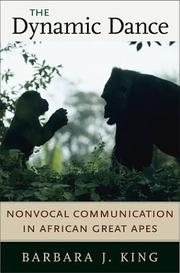| Listing 1 - 5 of 5 |
Sort by
|

ISBN: 0674039610 9780674039612 9780674015159 0674015150 Year: 2022 Publisher: Cambridge, MA
Abstract | Keywords | Export | Availability | Bookmark
 Loading...
Loading...Choose an application
- Reference Manager
- EndNote
- RefWorks (Direct export to RefWorks)
Mother and infant negotiate over food; two high-status males jockey for power; female kin band together to get their way. It happens among humans and it happens among our closest living relatives in the animal kingdom, the great apes of Africa. In this eye-opening book, we see precisely how such events unfold in chimpanzees, bonobos, and gorillas: through a spontaneous, mutually choreographed dance of actions, gestures, and vocalizations in which social partners create meaning and come to understand each other. Using dynamic systems theory, an approach employed to study human communication, Barbara King is able to demonstrate the genuine complexity of apes' social communication, and the extent to which their interactions generate meaning. As King describes, apes create meaning primarily through their body movements--and go well beyond conveying messages about food, mating, or predators. Readers come to know the captive apes she has observed, and others across Africa as well, and to understand "the process of creating social meaning." This new perspective not only acquaints us with our closest living relatives, but informs us about a possible pathway for the evolution of language in our own species. King's theory challenges the popular idea that human language is instinctive, with rules and abilities hardwired into our brains. Rather, The Dynamic Dance suggests, language has its roots in the gestural "building up of meaning" that was present in the ancestor we shared with the great apes, and that we continue to practice to this day.
Apes --- Animal communication --- Animal biocommunication --- Animal language --- Biocommunication, Animal --- Language learning by animals --- Animal behavior --- Behavior
Book
ISBN: 0674041992 9780674041998 Year: 2022 Publisher: Cambridge, MA
Abstract | Keywords | Export | Availability | Bookmark
 Loading...
Loading...Choose an application
- Reference Manager
- EndNote
- RefWorks (Direct export to RefWorks)
20 years ago Pepperberg set out to discover whether results of pigeon studies necessarily meant that other birds were incapable of mastering cognitive concepts and the rudiments of referential speech. This is a synthesis of her studies.
African gray parrot --- Cognition in animals. --- Animal communication. --- Animal cognition --- Animal intelligence --- Animal biocommunication --- Animal language --- Biocommunication, Animal --- Language learning by animals --- Animal behavior --- Behavior.
Book
ISBN: 3030857735 3030857727 Year: 2022 Publisher: Cham, Switzerland : Springer,
Abstract | Keywords | Export | Availability | Bookmark
 Loading...
Loading...Choose an application
- Reference Manager
- EndNote
- RefWorks (Direct export to RefWorks)
Sound production by animals. --- Vertebrates. --- Animal communication. --- Animal biocommunication --- Animal language --- Biocommunication, Animal --- Language learning by animals --- Animal behavior --- Vertebrata --- Chordata --- Animal vocalization --- Animals --- Vocalization by animals --- Animal communication --- Bioacoustics --- Sound production --- Vocalization
Book
ISBN: 9782227500839 2227500832 Year: 2022 Publisher: Montrouge Bayard
Abstract | Keywords | Export | Availability | Bookmark
 Loading...
Loading...Choose an application
- Reference Manager
- EndNote
- RefWorks (Direct export to RefWorks)
Beaucoup de ceux qui connaissent les animaux pensent qu'ils écrivent, à leur manière... Ils se parlent entre eux et avec d'autres. Les chiens laissent des messages pour les autres chiens sur les arbres et les réverbères, les chats le font aussi, ils disent quantité de choses dans les odeurs qu'ils laissent un peu partout. Ainsi le font également les loups, les sangliers, les poulpes avec leur encre, les chèvres des montagnes, les fourmis... Tous laissent des traces, des marques, des signatures, et chaque animal apprend à les lire. Bien sûr, les rats écrivent aussi. Et si nous imaginions qu'un jour nous aussi serons capables de les lire ? Un texte formidable, passionnant, étonnant, par la grande philosophe Vinciane Despret. [source éditeur]
Communication animale --- Biologie --- Philosophie. --- Animal communication --- Cognition in animals --- Animal cognition --- Animal intelligence --- Animal biocommunication --- Animal language --- Biocommunication, Animal --- Language learning by animals --- Animal behavior --- Communication avec les animaux
Book
ISBN: 9783030994846 Year: 2022 Publisher: Cham Springer International Publishing :Imprint: Springer
Abstract | Keywords | Export | Availability | Bookmark
 Loading...
Loading...Choose an application
- Reference Manager
- EndNote
- RefWorks (Direct export to RefWorks)
How Do Bees Find Flowers? During the history of bee research, scientists have peered deep into the inner life of bee colonies and learned much about the behaviour of these insects. Above all, the bee waggle dance has become a famous and extensively discussed phenomenon. Nevertheless, recent insights reveal that while bees are social insects inside the hive they also communicate with one another outside the hive. In this book, Jürgen Tautz, renowned German bee researcher, provides an entertaining, fresh and enlightened account for lay and professional readers, not only about the fascinating dance language but also about additional remarkable phenomena concerning information exchange between bees.
Animal communication. --- Honeybee --- Behavior. --- Animal biocommunication --- Animal language --- Biocommunication, Animal --- Language learning by animals --- Animal behavior --- Biology. --- Zoology. --- Cognition in animals. --- Neurosciences. --- Physiology. --- Psychology. --- Biological Sciences. --- Animal Cognition. --- Neuroscience. --- Animal Physiology. --- Behavioral Sciences and Psychology. --- Behavioral sciences --- Mental philosophy --- Mind --- Science, Mental --- Human biology --- Philosophy --- Soul --- Mental health --- Animal physiology --- Animals --- Biology --- Anatomy --- Neural sciences --- Neurological sciences --- Neuroscience --- Medical sciences --- Nervous system --- Animal cognition --- Animal intelligence --- Natural history --- Life sciences --- Life (Biology) --- Physiology
| Listing 1 - 5 of 5 |
Sort by
|

 Search
Search Feedback
Feedback About UniCat
About UniCat  Help
Help News
News